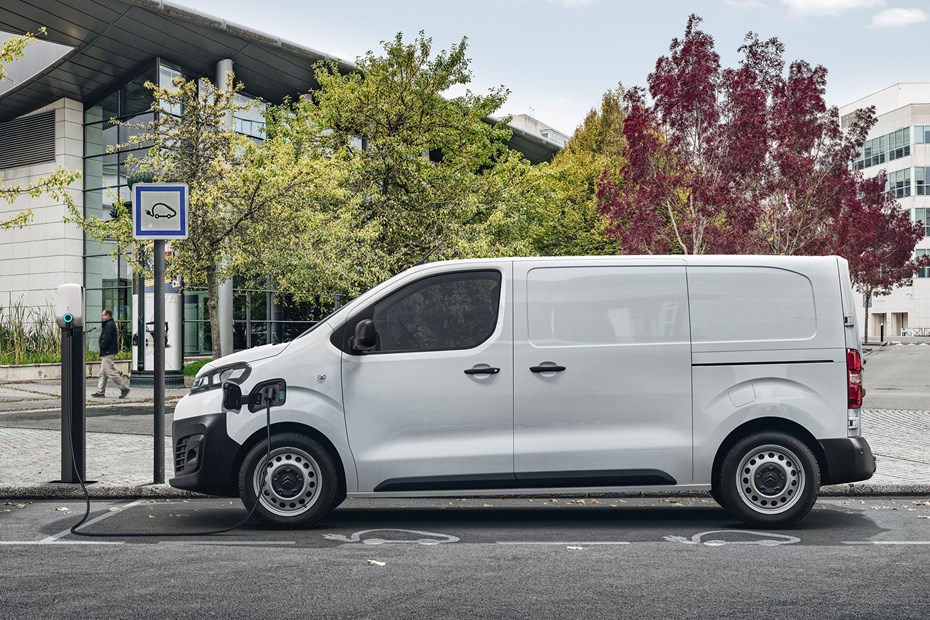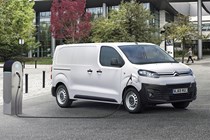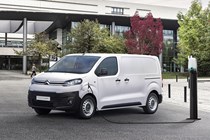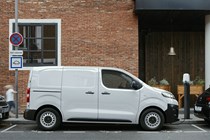UPDATE: read our Citroen e-Dispatch review for full details of this new electric van, including driving impressions, practicality and more.
Citroen has announced full pricing details for its new e-Dispatch electric van. Available to order now from £25,053, it matches the entry-price of its sister van, the Peugeot e-Expert, undercuts the similar Vauxhall Vivaro-e, and offers a higher ultimate payload than either of them.
Like the Peugeot, the Citroen comes in a choice of three trim levels and three body sizes – the Vauxhall has only two of each. With two battery sizes, driving range is up to 211 miles per charge according to the official figures, while an upgraded payload limit of 1,226kg is available on smaller battery versions.
Like its related vans, the e-Dispatch is also capable of towing a trailer up to 1,000kg in weight, something we’ve not seen from an electric van before.
Citroen e-Dispatch technical details
The e-Dispatch comes in all three available Dispatch body sizes: XS, M and XL. These all have the same roof height, but offer different body lengths, depending on whether you need maximum load space or a compact van body for tight city centres.

Each version is powered by the same 100kW electric motor. Equivalent to 136hp – roughly middle of the range for a diesel Dispatch – the motor also delivers 260Nm of torque. Not a huge amount by modern diesel standards, but due to the way electric motors work this will available right from standstill, so it shouldn’t struggle to shift the Citroen’s maximum payload.
The motor is fuelled – if that’s the right word – by a battery pack mounted under the load floor. This comes in 50kWh and 75kWh sizes. The larger the battery pack, the further the van will travel, but also the more the van will weigh. So you’ll find the smaller battery offers the greatest payload.
Maximum speed for the e-Dispatch is limited to 80mph. Good enough for motorways in the UK. There are three driving modes: Eco, Normal and Sport, and a choice of two braking modes, governing the amount of regen-braking you get when you lift off the accelerator.
What’s the driving range of the Citroen e-Dispatch electric van?
With the smaller 50kWh battery pack, the Citroen e-Dispatch has a claimed driving range of 148 miles.
With the larger 75kWh battery pack, the Citroen e-Dispatch has a claimed driving range of 211 miles.
The latter is by far the most of any electric van currently available (the Mercedes-Benz eVito Tourer claims more, but the Tourer is a people carrier rather than a panel van), though jointly available from the Peugeot e-Expert. The Vivaro-e currently claims 143-205 miles per charge.
The forthcoming Toyota Proace electric van should also offer similar figures, since this is built for Toyota by Stellantis, the new name for the firm that owns Citroen, Peugeot and Vauxhall.
How long does the e-Dispatch take to charge?
This depends on the power of the available charger.
Using a basic 7.4kW home charger – usually known as a wallbox – the smaller battery takes 7 hours and 30 minutes, the larger battery 11 hours and 20 minutes. A more powerful 11kW wallbox (which requires three-phase power) decreases the same to 4 hours 45 minutes and 7 hours.
However, the e-Dispatch is also compatible with very powerful public chargers right up to 100kW, which will give the smaller battery an 80% charge in 30 minutes, or the larger battery an 80% charge in 45 minutes.

You can charge it via a ‘robust’ regular three-pin plug as well, but even if you leave it all night you can only expect a 50% battery charge by the morning.
Citroen UK’s wallbox installer partner is Pod Point. There are workplace grants available from the UK government to help with the cost.
What’s the payload of the Citroen e-Dispatch?
The basic payload rating is 1,000kg (one tonne) on all versions, and the e-Dispatch comes in three lengths, as we’ve already covered above.
However, vans fitted with the smaller 50kWh battery pack will be available with an optional increased payload of up to 1,226kg, which is a really good amount for an electric van. This is not offered on 75kWh variants, which are capped at 1,000kg payload.
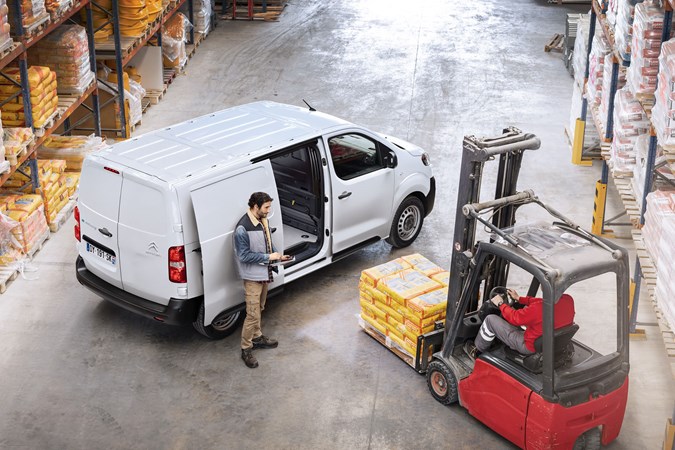
Citroen builds XS, M and XL length e-Dispatch models with 50kWh battery pack. However, Citroen UK says it has no plans to sell the XL van with the 50kWH battery here – meaning buyers will be restricted to the 75kWh XL.
Full load area and dimensions details can be found on our dedicated Citroen e-Dispatch dimensions page; there are no differences in load space between the electric and diesel versions of this medium van.
Most buyers are expected to opt for the larger battery pack due to concerns about range anxiety – the fear of running out of charge. This despite PSA’s research suggesting that the smaller battery pack will cover the routine daily driving needs of 83% of its van customers.
Can the Citroen e-Dispatch tow a trailer?
Yes. It’s rated to tow up to 1,000kg – a little way shy of the 1,400-2,500kg payload rating the diesel models offer.
But it’s so rare to see an electric van rated to tow at all that any capacity is better than nothing at this stage.
What about trim levels and standard equipment?
The e-Dispatch comes in three trim levels: X, Enterprise and Driver.
X models come with electric, heated door mirrors, air-conditioning, DAB radio with Bluetooth, Connect Box with Emergency Assistance, cruise control and speed limiter.
Enterprise adds rear parking sensors, alarm, automatic lights and wipers, 7.0-inch touchscreen infotainment system with Apple CarPlay and Android Auto, and the Moduwork dual passenger seat with load-through bulkhead.
The Driver variants come with autonomous emergency braking, front parking sensors, lane departure warning system, blind-spot monitors, 180-degree rear parking camera, and sat-nav.
Only the Enterprise is available on all body lengths; the X and Driver models are limited to the Standard size – with X only offered with the 50kW battery pack and Driver only available as a 75kW model.
Anything else we need to know?
Well, the interior is similar to the standard van, except with slightly different instruments, a new set of display options for the touchscreen infotainment system, and a minimalist drive selector – like all electric vans, the e-Dispatch has only a single-speed transmission, so should function like a super-smooth automatic.
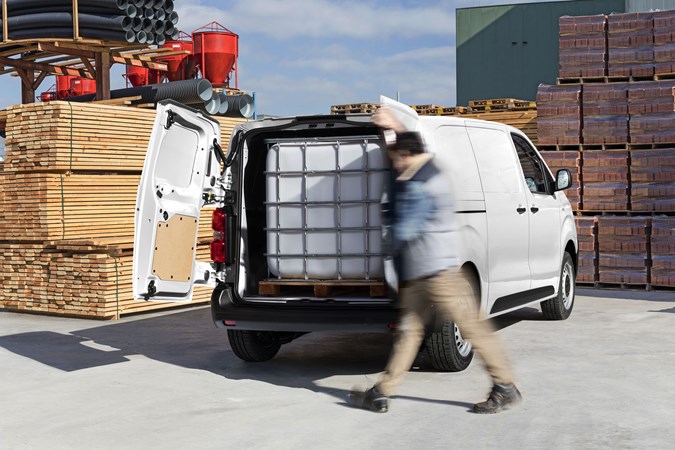
The suspension uses variable stiffness springs and load-dependent shock absorbers to maintain a comfortable ride regardless of how loaded (or not) the van is.
As with most electric vans you’ll be able to pre-condition the cabin before you unplug – which means you can set your preferred temperature ahead of setting off, saving time and energy. Your battery pack will last longer while driving as a result, and you won’t have to wait for the van to defrost in winter.
You can set the pre-conditioning and control a number of other functions using a MyCitroen smartphone app.
Also good to know is that the batteries are covered by an eight-year / 100,000-mile warranty that guarantees they will maintain 70% of their original capacity. There are plans for a battery certification service to make it easier to sell the van secondhand.
The rest of the van is covered by the same three-year warranty as a regular Dispatch.
When does the Citroen e-Dispatch electric van go on sale and what will it cost?
Prices start at £25,053 for the Citroen e-Dispatch X – excluding VAT but including the UK government Plug-in Van Grant (PIVG) discount; without the grant, the entry price is £32,965. At the top of the range, the e-Dispatch Driver is £34,380 with the grant or £42,380 without it.
Citroen has already gone on record to say it expects total life costs to be no greater than the diesel equivalent. This means that although the initial purchase price of the e-Dispatch may be higher (and it’s not by much), the running costs should be lower – including servicing, which PSA says should cost 30% less.
Also read:
>> Our Citroen e-Dispatch electric van review
>> The best electric vans you can buy now
>> The Parkers guide to electric vans
>> Future electric vans coming soon
Just so you know, we may receive a commission or other compensation from the links on this website - read why you should trust us.


